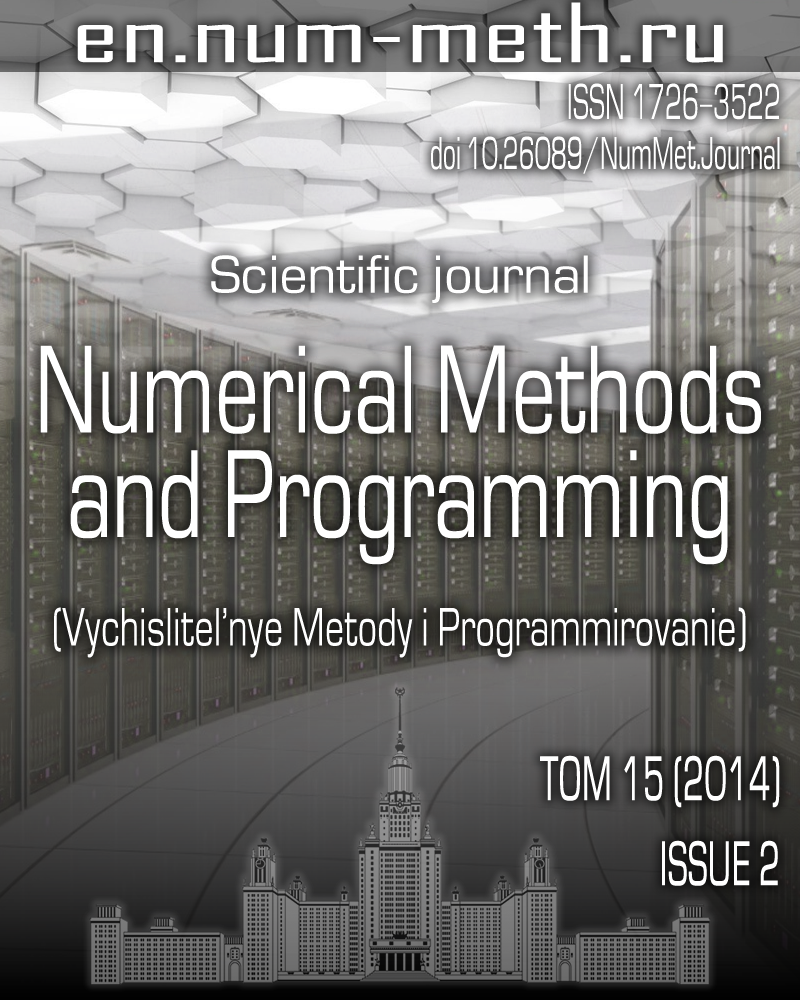Simulation of a molecular structure formation as a result of thermal disruption in amorphous carbon
Keywords:
Abstract
A multiscale model of phase-change memory is proposed. A phase transition is self-consistently simulated on three different time-space levels. On the first level, we use ab initio quantum molecular dynamics calculations with consideration of a temperature distribution. On the second level, the time-dependent evolution of the electronic density is simulated on the basis of the reduced Ehrenfest molecular dynamics near the line of the phase transition of the second kind. On the third level, we use the heat conduction equation in continuous media to calculate a new temperature distribution. Our calculations show the appearance of a graphitic layer structure from an amorphous state under the influence of temperature effects. The electronic density evolution leads to a localization in space of the electric conductivity. A space-localized heat source causes the thermal instability and, hence, maintains the structure. Such a behavior could explain the appearance of the S-shaped volt-ampere characteristic in a conducting nanodot during experiments. The IBM BlueGene/P supercomputer installed at the Faculty of Computational Mathematics and Cybernetics of the Lomonosov Moscow State University was used.
Published
Issue
Section
References
- Rieth M., Schommers W. Handbook of Theoretical and Computational Nanotechnology. Karlsruhe: Forschungszentrum Karlsruhe, 2006.
- Wuttig M., Yamada N. Phase-change materials for rewriteable data storage // Nat. Mater. 2007. 6. 824-832.
- Liljeroth P., Repp J., Meyer G. Current-induced hydrogen tautomerization and conductance switching of naphthalocyanine molecules // Science. 2007. 317. 1203-1206.
- Standley B., Bao W., Zhang H., et al. Graphene-based atomic-scale switches // Nano Lett. 2008. 8, N 10. 3345-3349.
- Попов А.М. Вычислительные нанотехнологии. М.: КноРус, 2014.
- Van der Molen S.J., Liljeroth P. Charge transport through molecular switches // Journal of Physics: Condensed Matter. 2010. 22, N 13, 133001-133030.
- Meijer G.I. Who wins the nonvolatile memory race? // Science. 2008. 319. 1625-1626.
- Sebastian A., Pauza A., Rossel C., Shelby R.M., Rodriguez A.F., Pozidis H., Eleftheriou E. Resistance switching at the nanometre scale in amorphous carbon // New J. Phys. 2011. 13, N 1. Article No. 013020.
- Shumkin G.N., Zipoli F., Popov A.M., Curioni A. Multiscale quantum simulation of resistance switching in amorphous carbon // Procedia Computer Science. 2012. 9. 641-650.
- Шумкин Г.Н., Попов А.М. Моделирование из первых принципов фазового перехода в аморфном углероде // Математическое моделирование. 2012. 24, № 10. 65-79.
- Takai K., Oga M., Sato H., et al. Structure and electronic properties of a nongraphitic disordered carbon system and its heat-treatment effects // Phys. Rev. B. 2003. 67. 214202-214212.
- Jornada F.H., Gava V., Martinotto A.L., Cassol L.A., Perottoni C.A. Modeling of amorphous carbon structures with arbitrary structural constraints // J. Phys. Condens. Matter. 2010. 22, N 39. Article No. 395402.
- Marks N.A., McKenzie D.R., Pailthorpe B.A., Bernasconi M., Parrinello M. Ab initio simulations of tetrahedral amorphous carbon // Phys. Rev. B. 1996. 54, N 14. 9703-9714.
- He Y., Zhang J., Guan X., et. al. Molecular dynamics study of the switching mechanism of carbon-based resistive memory // IEEE Trans. on Electron Dev. 2010. 57, N 12. 3434-3441.
- Car R., Parrinello M. Unified approach for molecular dynamics and density-functional theory // Phys. Rev. Lett. 1985. 55. 2471-2474.
- Kohn W. Density functional and density matrix method scaling linearly with the number of atoms // Phys. Rev. Lett. 1996. 76. 3168-3171.
- Marx D., Hutter J. Ab initio molecular dynamics: theory and implementation // Modern Methods and Algorithms of Quantum Chemistry. Vol. 1. Julich: Forschungszentrum Jülich, 2000. 301-449.
- Andreoni W., Curioni A. New advances in chemistry and materials science with CPMD and parallel computing // Parallel Comput. 2000. 26, N 7/8. 819-842.
- Bekas C., Curioni A., Andreoni W. Atomic wavefunction initialization in ab initio molecular dynamics using distributed Lanczos // Parallel Comput. 2008. 34, N 6. 441-450.
- Andrade X., Castro A., Zueco D., Alonso J.L., Echenique P., Falceto F., Rubio A. A modified Ehrenfest formalism for efficient large-scale ab initio molecular dynamics // J. Chem. Theory Comput. 2009. 5, N 4. 728-742.
- Martyna G.J., Klein M.L., Tuckerman M. Nosé-Hoover chains: the canonical ensemble via continuous dynamics // J. Chem. Phys. 1992. 97, N 4. 2635-2643.


